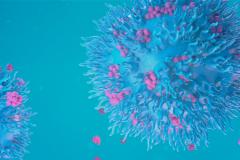Dr. Megan Levings and her team have recently published two papers on the very different functions and uses of regulatory T cells (Tregs). Tregs are immune cells that help to rein in immune responses to ensure that they don’t go too far and begin harming healthy tissues in their pursuit of foreign invaders.
- Overview
-
My research interests are diverse but focused. I have a firm interest in bone tumors and a soft spot for soft tissue sarcomas, including understanding the underlying pathophysiology and translational work in the clinical pathology lab setting. I joined the 2019-2021 cohort within the Children’s Oncology Group Young Investigator Program with a focus in the bone tumor group. I also am interested in exploring cell signaling and cell-to-cell communication through conventional molecular and proteomic analysis with fellow investigators. My second area of research interest is in gastrointestinal pathology, particularly eosinophilic esophagitis (EoE). Through these EoE projects, I enjoyed expanding my experience in immunology which builds on an interest during my fellowship at Lurie Children’s Hospital of Chicago, which explored transplant immunology and the effect on the gastrointestinal tract. I also enjoy expanding my experience in the area of transplant immunology. My last primary area of interest is in developmental pathology, which often stems from identifying common pathologic findings in the interesting cases I encounter at BC Children’s and Women’s Hospital. I have an interest in leadership and administration, which blossomed during my time as Cohort 2 in the BC Patient Safety and Quality Council’s Clinician Quality Academy.
- Publications
-
Pathology reporting of hepatoblastoma resections: recommendations from the international collaboration on cancer reporting
Histopathology
Dolores H López-Terrada and Fleur Webster and Rita Alaggio and Jonathan W Bush and Soo-Jin Cho and Ronald R de Krijger and Takeshi Inoue and Allison F O'Neill and Antonio R Perez-Atayde and Sarangarajan Ranganathan and Jens Stahlschmidt and Yukichi Tanaka and Marta Cohen and Miguel Reyes-Múgica
DOI: 10.1111/his.15536
12/2025Recommendations for the diagnosis and management of eosinophilic esophagitis in adults and children in Canada: a Delphi consensus project
Journal of the Canadian Association of Gastroenterology
Vishal Avinashi and Milli Gupta and Beth A Payne and Haneen Amhaz and Alisha T Temirova and Waqqas Afif and Dhandapani Ashok and Janice Barkey and David Burnett and Jonathan W Bush and Scott Cameron and Stuart Carr and Dina El Demellawy and Stephanie Erdle and Hien Q Huynh and Jennifer Griffin and Samir C Grover and Kelly Grzywacz and Samira Jeimy and Hin Hin Ko and Gina Lacuesta and Margaret Marcon and Serge Mayrand and Harrison Petropolis and David Rodrigues and Mary Sherlock and Christine Song and Natacha Tardio and Timothy K Vander Leek and Meagan Vurzinger and Brock Williams and Ted Xenodemetroupolous and Christopher Ma and Edmond S Chan
DOI: 10.1093/jcag/gwaf022
12/2025Spatial and multi-omic profiling reveals genes and pathways associated with cytotoxic lymphocyte infiltration in malignant rhabdoid tumor
Marco Marra and Dan Jin and Joshua Dubland and Elizabeth Mullen and James Geller and Jonathan Bush
DOI: 10.21203/rs.3.rs-7303174/v1
08/2025Immunohistochemical study of histone protein 3 modification in pediatric osteosarcoma identifies reduced H3K27me3 as a marker of poor treatment response
PLOS ONE
Sebastian Kondratowski and Danielle Cohen and Rebecca J. Deyell and Ash Sandhu and Jonathan W. Bush
DOI: 10.1371/journal.pone.0309471
11/2024Characterization of Switch/Sucrose Nonfermenting Complex Proteins and Nestin Expression in a Cohort of Pediatric Central Nervous System Tumors.
Applied immunohistochemistry & molecular morphology : AIMM
Wang XQ and Tessier-Cloutier B and Saunders J and Harvey M and Armstrong L and Ng T and Dunham C and Bush JW
DOI: 10.1097/pai.0000000000001122
PubMed: 37036408
04/2023ASAP-Automated Sonication-Free Acid-Assisted Proteomes-from Cells and FFPE Tissues.
Analytical chemistry
Barnabas GD and Verena Goebeler and Tsui J and Bush JW and Philipp F. Lange
DOI: 10.1021/acs.analchem.2c04264
PubMed: 36724070
02/2023Multi-omic profiling of the leukemic microenvironment shows bone marrow interstitial fluid is distinct from peripheral blood plasma.
Experimental hematology & oncology
Nierves L and Guo J and Chen S and Tsui J and Uzozie AC and Bush JW and Huan T and Lange PF
DOI: 10.1186/s40164-022-00310-0
PubMed: 36109804
09/2022Application of the Eosinophilic Esophagitis Histology Scoring System Grade Scores in Patients at British Columbia Children's Hospital.
Fetal and pediatric pathology
Cruz J and Michael Irvine and Vishal Avinashi and Edmond Chan and Vallance BA and Lianne Soller and Bruce Vallance
DOI: 10.1080/15513815.2022.2028950
PubMed: 35094661
01/2022Quantifying Proximal Collecting Tubule Deficiency in Angiotensin-Converting Enzyme Inhibitor and Angiotensin II Receptor Blocker Fetopathy
Pediatric and Developmental Pathology
Jessica Saunders and Allison Marie Callejas Salgado and Joseph Y Ting and Cherry Mammen and Jefferson Terry and Jonathan W Bush
DOI: 10.1177/10935266211018922
09/2021SMARCA4 -deficient rhabdoid tumours show intermediate molecular features between SMARCB1 -deficient rhabdoid tumours and small cell carcinomas of the ovary, hypercalcaemic type
The Journal of Pathology
Mamy Andrianteranagna and Joanna Cyrta and Julien Masliah-Planchon and Karolina Nemes and Alice Corsia and Amaury Leruste and Dörthe Holdhof and Uwe Kordes and Daniel Orbach and Nadège Corradini and Natacha Entz-Werle and Gaëlle Pierron and Marie-Pierre Castex and Anne Brouchet and Noëlle Weingertner and Dominique Ranchère and Paul Fréneaux and Olivier Delattre and Jonathan Bush and Alexandra Leary and Michael C. Frühwald and Ulrich Schüller and Nicolas Servant and Franck Bourdeaut
DOI: 10.1002/path.5705
05/2021Atypical teratoid/rhabdoid tumors (ATRTs) with SMARCA4 mutation are molecularly distinct from SMARCB1-deficient cases
Acta Neuropathologica
Dörthe Holdhof and Pascal D. Johann and Michael Spohn and Michael Bockmayr and Sepehr Safaei and Piyush Joshi and Julien Masliah-Planchon and Ben Ho and Mamy Andrianteranagna and Franck Bourdeaut and Annie Huang and Marcel Kool and Santhosh A. Upadhyaya and Anne E. Bendel and Daniela Indenbirken and William D. Foulkes and Jonathan W. Bush and David Creytens and Uwe Kordes and Michael C. Frühwald and Martin Hasselblatt and Ulrich Schüller
DOI: 10.1007/s00401-020-02250-7
2020Poor Correlation of Oral Swabs with Esophageal Eosinophil Counts.
Dysphagia
Avinashi V and Chan JM and Bush JW and Vallance BA and Yang H and Portales-Casamar E and Soller L and Mill C and Chan ES
DOI: 10.1007/s00455-019-10082-1
PubMed: 31773332
11/2019Spindle Epithelial Tumor with Thymus-Like Differentiation (SETTLE): A Case Report
Fetal and Pediatric Pathology
Cyrus L Matheson and Geoffrey K Blair and Jonathan Bush
DOI: 10.1080/15513815.2019.1600625
09/2019Novel Exonic Deletions in TTC7A in a Newborn with Multiple Intestinal Atresia and Combined Immunodeficiency
Journal of Clinical Immunology
Jessica R. Saunders and Anna Lehman and Stuart E. Turvey and Jie Pan and Evica Rajcan-Separovic and Aleixo M. Muise and Jonathan W. Bush
DOI: 10.1007/s10875-019-00669-6
08/2019Systematic testing and specificity mapping of alloantigen-specific chimeric antigen receptors in regulatory T cells.
JCI insight
Nicholas Dawson and Caroline Lamarche and Hoeppli RE and Bergqvist P and Fung VC and McIver E and Huang Q and Gillies J and Speck M and Orban PC and Jonathan Bush and Mojibian M and Megan K. Levings
DOI: 10.1172/jci.insight.123672
PubMed: 30753169
03/2019Pediatric Eosinophilic Esophagitis Is Associated With Increased Lamina Propria Immunoglobulin G4-Positive Plasma Cells.
Journal of pediatric gastroenterology and nutrition
Mohammad N and Vishal Avinashi and Chan E and Bruce Vallance and Elodie Portales-Casamar and Jonathan Bush
DOI: 10.1097/mpg.0000000000001949
PubMed: 29509633
08/2018Pediatric Pathology Fellowship Recruitment—Report of a Survey Conducted by the Fellowship Committee of the Society for Pediatric Pathology
Pediatric and Developmental Pathology
Singh, V. and Eldin, K. and Timmons, C. and Bush, J. and Rabah, R.
DOI: 10.1177/1093526617722905
2018Eosinophilic density in graft biopsies positive for rejection and blood eosinophil count can predict development of post-transplant digestive tract eosinophilia
Pediatric Transplantation
Bush, J.W. and Mohammad, S. and Melin-Aldana, H. and Kagalwalla, A.F. and Arva, N.C.
DOI: 10.1111/petr.12693
2016Treatment of neuroblastoma in congenital central hypoventilation syndrome with a PHOX2B polyalanine repeat expansion mutation: New twist on a neurocristopathy syndrome
Pediatric Blood and Cancer
Armstrong, A.E. and Weese-Mayer, D.E. and Mian, A. and Maris, J.M. and Batra, V. and Gosiengfiao, Y. and Reichek, J. and Madonna, M.B. and Bush, J.W. and Shore, R.M. and Walterhouse, D.O.
DOI: 10.1002/pbc.25572
2015Combined robotic and open approach to excision of accessory bladder and urethral triplication
Journal of Pediatric Urology
Bowen, D.K. and Glaser, A.P. and Bush, J.W. and Cheng, E.Y. and Gong, E.M.
DOI: 10.1016/j.jpurol.2014.11.009
2015Deconstructing the diagnosis of hemophagocytic lymphohistiocytosis using illustrative cases
Journal of Hematopathology
Weinstein, J.L. and Badawy, S.M. and Bush, J.W. and Schafernak, K.T.
DOI: 10.1007/s12308-015-0254-3
2015Intracranial atypical teratoid/rhabdoid tumor presenting as an axillary mass: A case report and review of literature
Pediatric and Developmental Pathology
Bush, J.W. and Hancock, B.J. and Israels, S.J. and Ellison, D.W. and Stefanovici, C. and Krawitz, S.
DOI: 10.2350/14-01-1427-CR.1
2014Outcomes of persons with blastomycosis involving the central nervous system
Diagnostic Microbiology and Infectious Disease
Bush, J.W. and Wuerz, T. and Embil, J.M. and Del Bigio, M.R. and McDonald, P.J. and Krawitz, S.
DOI: 10.1016/j.diagmicrobio.2013.03.002
2013 - Research
-
Sarcoma including the role of SWI/SNF proteins
Rhabdoid tumors are a group of primitive cancers that are often highly aggressive and are generally defined by a mutation in the SWI/SNF pathway, including the genes SMARCB1 (INI1) and SMARCA4 (BRG1). The Bush lab was one of the first groups to explore the use of BRG1 IHC to identify a subset of RTs that were INI1-retained. Further work is ongoing looking at the immune microenvironment of RTs as these are generally considered to have low tumor mutational burden and thus are immune-cold tumors, yet there appears to be heterogenous areas of tumor cell infiltration. Utilizing spatial genomics and proteomics, we hope to better understand RT inter and intra-tumoral heterogeneity.Pediatric Bone Tumors
The Bush lab uses fresh and fixed tumor tissue from the two most common malignant bone tumors, Osteosarcoma (OS) and Ewing Sarcoma (ES), to explore novel antibodies using immunohistochemistry (IHC) for diagnosis and prognosis. This includes developing tissue microarrays (TMAs) to test a number of antibodies across a wide variety of samples. Some work has shown that a particular methylation pattern in the diagnostic biopsies of OS may predict good or bad disease behaviour.Novel Diagnostic and Precision Methods in Pediatric Tumors
Working with collaborators, the Bush lab is helping to establish a proteomics pipeline that will demonstrate the utility of proteomics in clinical applications. This includes providing diagnostic, prognostic, and in some cases predictive markers that will allow for personalized therapies based on relative over or under-abundance of particular proteins. Promising results have been seen in OS and neuroblastoma to date. In collaboration with researchers at UBC and the NIH, the Bush lab is exploring the use of machine learning (ML) in osteosarcoma. This work will develop a pipeline for assessing tissue quality for the purpose of molecular studies, facilitate histologic classification of OS for clinical trials, and to explore potential prognostic markers as identified by supervised and unsupervised ML. The Bush lab has worked with collaborators in establishing a novel method of developing patient-derived xenografts using a less expensive model than the typical mouse system. Through this chorioallantoic membrane (CAM) modelling system, we have been able to facilitate tumor expansion in both highly aggressive and indolent tumors, and have worked to demonstrate the utility of the CAM system for drug testing.Eosinophilic Esophagitis (EoE)
Our group was the first to show that pediatric EoE was associated with increased lamina propria IgG4-positive plasma cells, which is being explored as to whether food-specific IgG4 can be used to evaluate for EoE disease activity. Ongoing work by the Bush lab has included utilizing novel techniques to evaluate EoE slides as well as potential spatial differences between the immune and squamous cell compartments.Research Group MembersDaniela Buitrago, Graduate Research Assistant
Michelle Dittrick, Clinical Research Program Manager
Arla Shio, Undergraduate Research Assistant
Kayla Wen, INSPIRE PROGRAM TRAINEE





